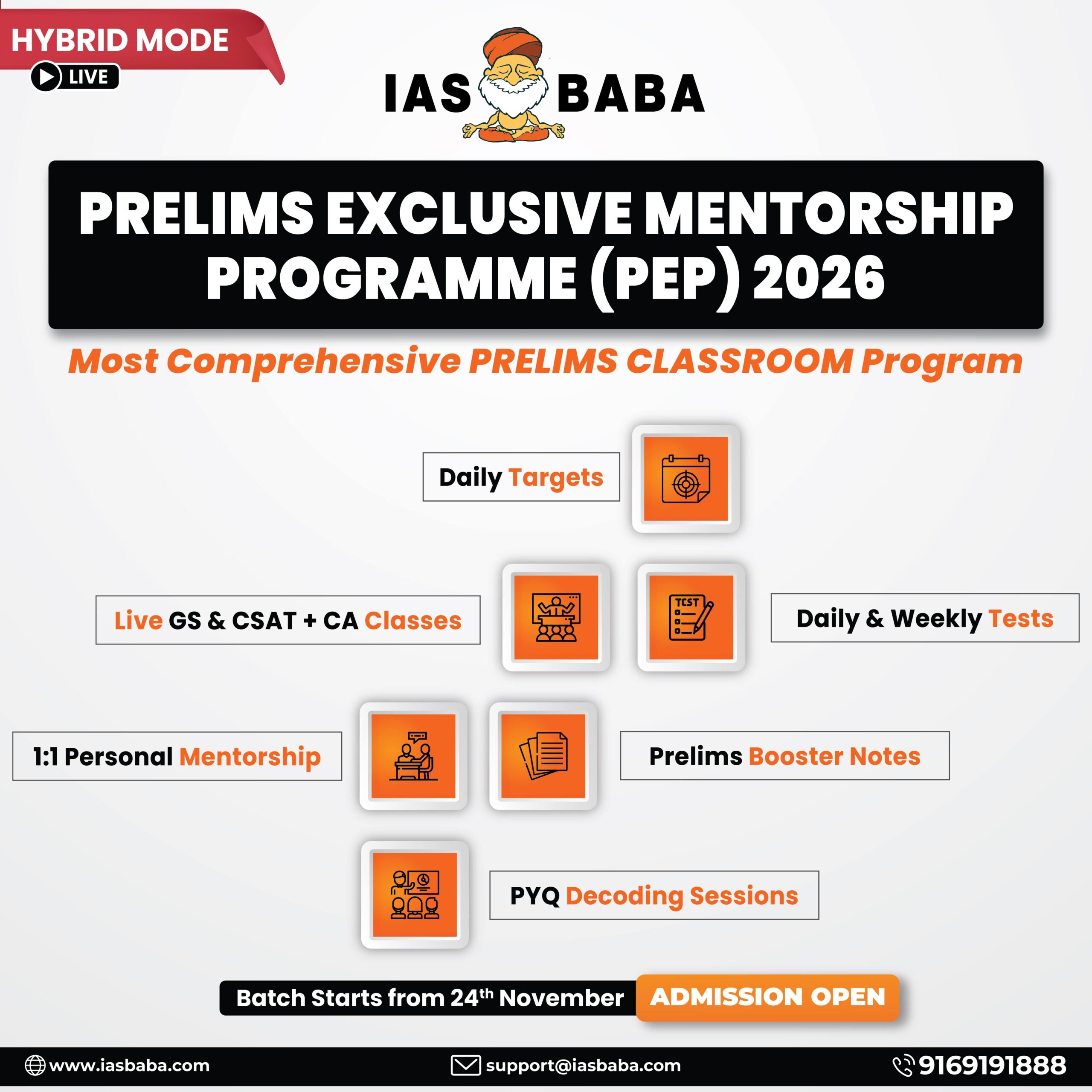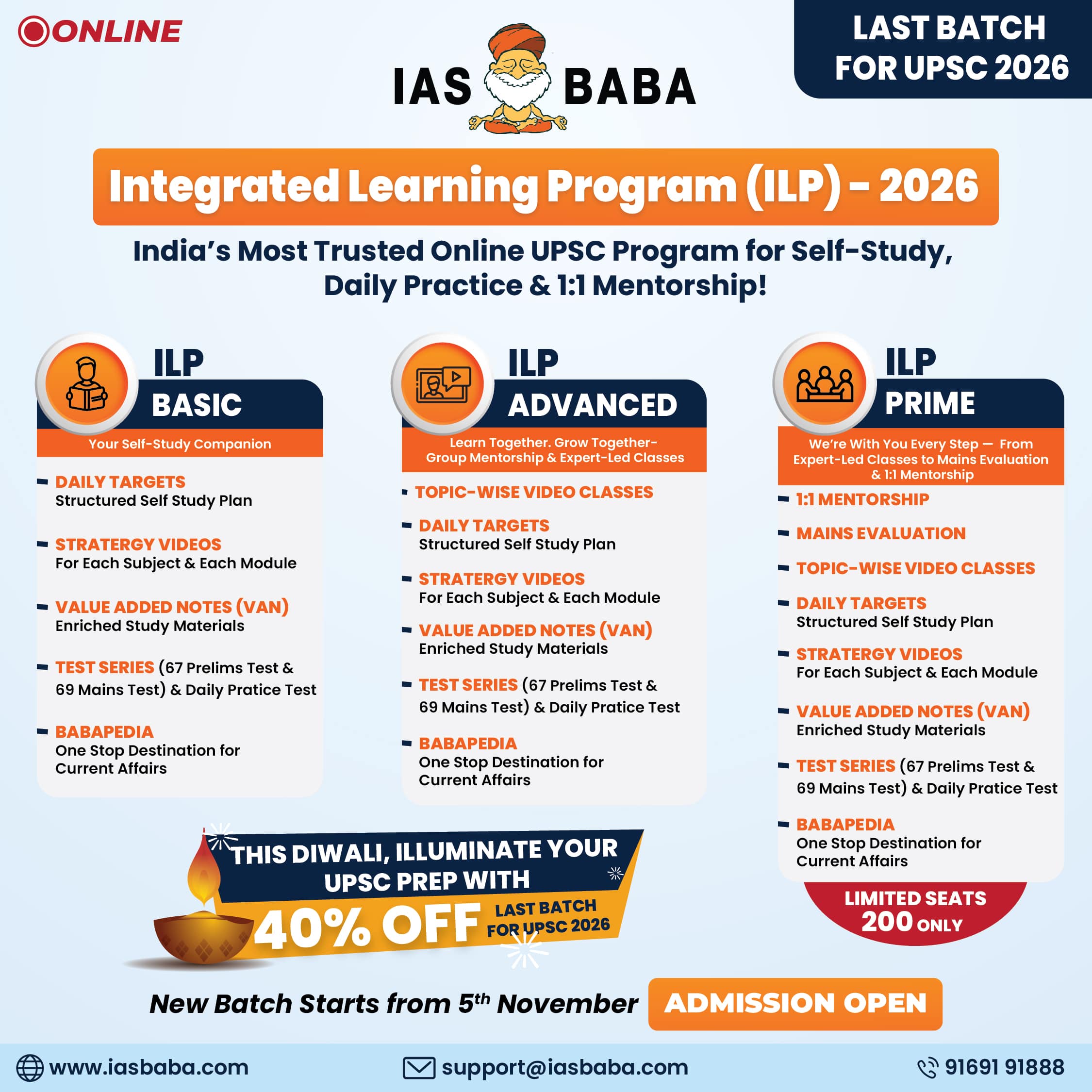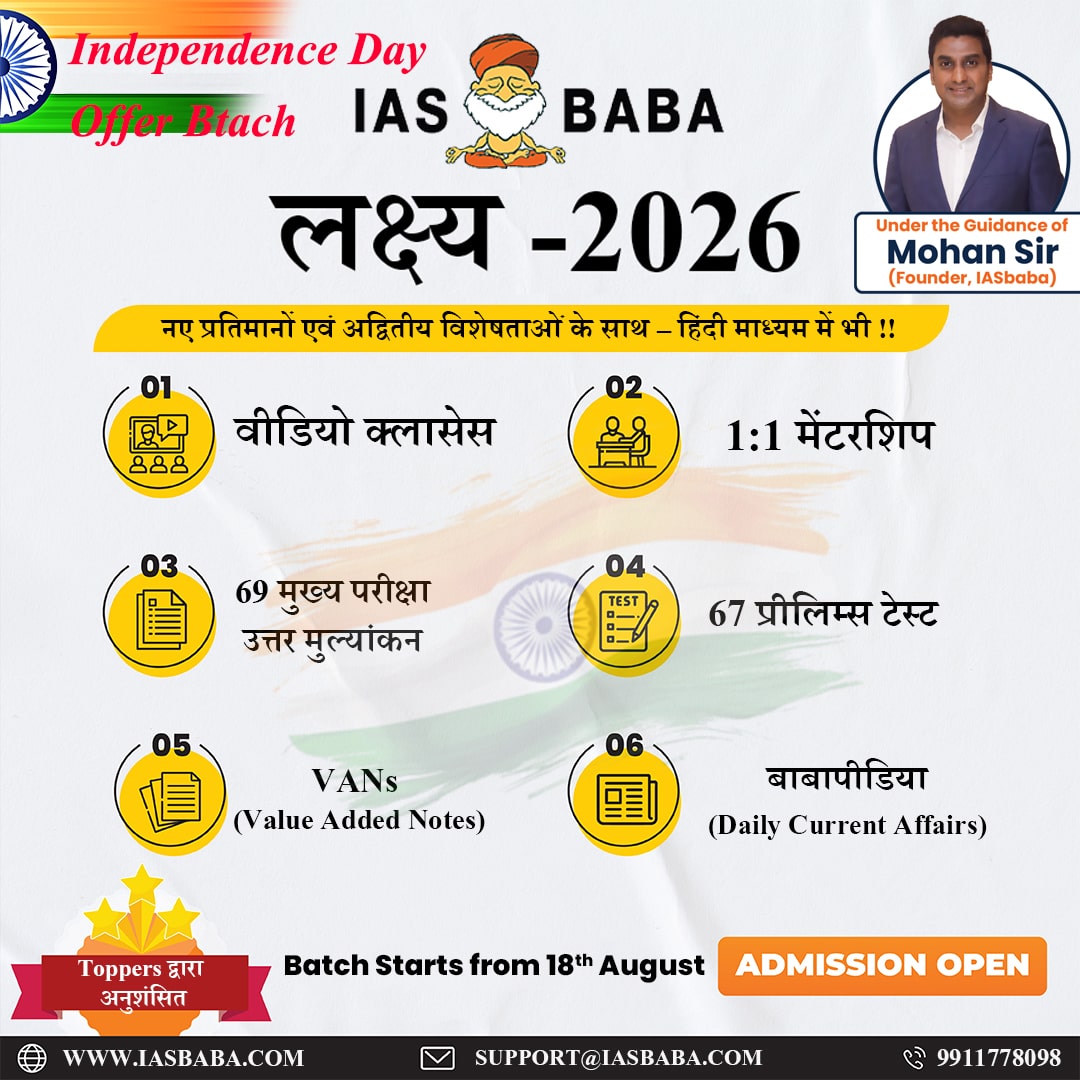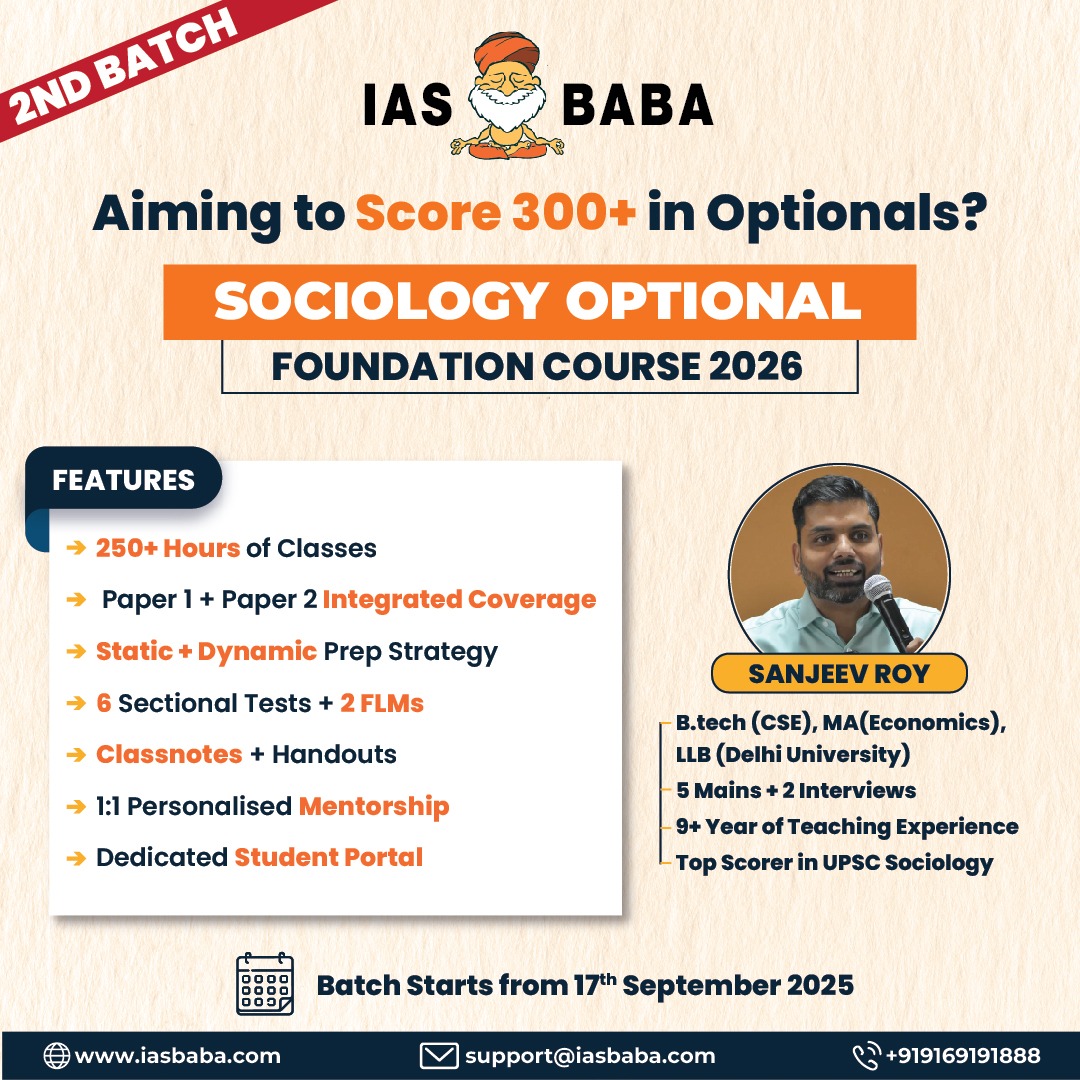IASbaba's Daily Current Affairs Analysis
Archives
(PRELIMS Focus)
Category: SCIENCE AND TECHNOLOGY
Context: ICAR-National Institute of High Security Animal Diseases (NIHSAD), Bhopal, being designated as a Category A Rinderpest Holding Facility (RHF) by the World Organisation for Animal Health (WOAH) and the FAO
Decoding Context:
What Is Rinderpest?
Rinderpest, or “cattle plague,” was a deadly livestock disease eradicated globally in 2011. However, Rinderpest Virus-Containing Material (RVCM) is still stored in select labs, posing potential biosecurity risks if mishandled.
India’s Recognition
NIHSAD, Bhopal, is now one of only six Category A RHFs worldwide, alongside facilities in the UK, USA, France, Japan, and Ethiopia. It is a high-containment BSL-3 lab and India’s national RVCM repository since 2012.
India applied for this status in 2019, and after a thorough international inspection in March 2025, it was officially granted RHF status at the 92nd WOAH General Session in May 2025.
Significance
- Strengthens India’s role in global biosecurity and disease prevention
- Validates India’s biosafety protocols and emergency preparedness
- Supports future research and vaccine material management
- Enhances India’s standing as a leader in animal health containment
Learning Corner:
List of important human and animal diseases along with their causative pathogens
- Viral Diseases
| Disease | Causative Virus |
|---|---|
| Influenza (Flu) | Influenza virus (Type A, B, C) |
| COVID-19 | SARS-CoV-2 |
| Dengue | Dengue virus (Flavivirus) |
| Measles | Measles virus (Paramyxovirus) |
| Mumps | Mumps virus (Paramyxovirus) |
| Rubella (German Measles) | Rubella virus |
| Rabies | Rabies virus (Lyssavirus) |
| Poliomyelitis | Poliovirus (Enterovirus) |
| Hepatitis A & E | HAV, HEV |
| Hepatitis B & C | HBV (DNA), HCV (RNA) |
| HIV/AIDS | Human Immunodeficiency Virus |
| Smallpox (Eradicated) | Variola virus |
| Chickenpox | Varicella-Zoster virus |
| Rinderpest (Eradicated) | Rinderpest virus (Morbillivirus) |
| Foot-and-Mouth Disease | FMD virus (Aphthovirus) |
- Bacterial Diseases
| Disease | Causative Bacterium |
|---|---|
| Tuberculosis | Mycobacterium tuberculosis |
| Typhoid | Salmonella typhi |
| Cholera | Vibrio cholerae |
| Plague | Yersinia pestis |
| Diphtheria | Corynebacterium diphtheriae |
| Pertussis (Whooping Cough) | Bordetella pertussis |
| Tetanus | Clostridium tetani |
| Leprosy (Hansen’s Disease) | Mycobacterium leprae |
| Pneumonia | Streptococcus pneumoniae, others |
| Syphilis | Treponema pallidum |
| Anthrax | Bacillus anthracis |
| Brucellosis | Brucella species |
III. Protozoan Diseases
| Disease | Causative Protozoan |
|---|---|
| Malaria | Plasmodium spp. (P. falciparum, etc.) |
| Amoebiasis | Entamoeba histolytica |
| Sleeping Sickness | Trypanosoma brucei |
| Chagas Disease | Trypanosoma cruzi |
| Giardiasis | Giardia lamblia |
| Leishmaniasis (Kala Azar) | Leishmania donovani |
| Toxoplasmosis | Toxoplasma gondii |
- Fungal Diseases
| Disease | Causative Fungus |
|---|---|
| Ringworm | Trichophyton spp., others |
| Athlete’s Foot | Tinea pedis |
| Candidiasis (Thrush) | Candida albicans |
| Aspergillosis | Aspergillus spp. |
| Histoplasmosis | Histoplasma capsulatum |
- Prion Diseases (Rare, Degenerative)
| Disease | Causative Agent |
|---|---|
| Creutzfeldt–Jakob Disease (CJD) | Prions (misfolded proteins) |
| Mad Cow Disease (BSE) | Prions |
Source: PIB
Category: ECONOMICS
Context: Revision of GDP Base Year and Methodology
Purpose of Revising the Base Year:
- Reflect Current Economy: As economies evolve, sectoral contributions, consumption patterns, and new industries (like digital platforms and fintech) emerge. A revised base year ensures GDP reflects these changes.
- Use Better Data and Methods: Improved surveys and administrative records enhance the accuracy of GDP estimates. Methodological updates align with global statistical standards.
- Capture Post-Pandemic Shifts: Events like COVID-19 altered production and consumption patterns. A new base year captures these realities.
- Ensure International Comparability: Aligns India’s data with global norms, boosting credibility.
How It Works:
- An expert committee recommends changes.
- A “normal” year is selected as the base year—free of economic shocks and recent enough to be relevant.
Why the 2026 Revision Matters for India
Key Implications:
- Improved Accuracy: Addresses concerns from the 2015 revision and provides more transparent, realistic estimates using 2022–23 as the new base year.
- Better Policy-Making: More precise data aids in targeting policies, especially in emerging sectors.
- Boosts Investor Confidence: Up-to-date economic indicators enhance India’s image and trustworthiness in global markets.
- Refined Growth Trends: Revised data may adjust past GDP growth rates, offering a clearer picture of the economy.
- Harmonized Indicators: Other indices like CPI and IIP will also be updated, ensuring consistency.
Learning Corner:
Important terms related to GDP
- Gross Domestic Product (GDP)
Definition:
GDP is the total monetary value of all final goods and services produced within the geographical boundaries of a country during a specific time period (usually a year).
Includes:
- Production by both domestic and foreign entities within the country
- Measured at market prices
Types:
- Nominal GDP: At current market prices
- Real GDP: Adjusted for inflation (base year prices)
- Gross National Product (GNP)
Definition:
GNP is the total monetary value of all final goods and services produced by the residents (nationals) of a country in a given period, irrespective of their location.
Formula:
GNP = GDP + Net Factor Income from Abroad (NFIA)
NFIA = Income earned by Indians abroad – Income earned by foreigners in India
- Net National Product (NNP)
Definition:
NNP is the GNP after deducting depreciation (consumption of fixed capital). It shows the net output available for consumption or saving.
Formula:
NNP = GNP – Depreciation
Two measures:
- NNP at Market Price
- NNP at Factor Cost (also called National Income)
- National Income (NI)
Definition:
National Income is the net monetary value of all goods and services produced by a country’s nationals during a year, measured at factor cost.
Formula:
National Income = NNP at Factor Cost
Includes:
- Wages and salaries
- Rent
- Interest
- Profits
- Mixed income of self-employed
Source: THE INDIAN EXPRESS
Category: ECONOMICS
Context : French aerospace firm Dassault Aviation and Reliance Aerostructure Ltd have announced a joint venture to manufacture Falcon 2000 business jets in Nagpur, India.
Key Highlights
- Location: MIHAN SEZ, Nagpur
- Aircraft: Falcon 2000; parts of Falcon 6X & 8X
- Scope: Fuselage and wing assembly to be shifted to India
- Estimated Capacity: Up to 24 aircraft annually
- Timeline: First made-in-India jet by 2028
Significance
- Make in India & Atmanirbhar Bharat: Major boost to domestic aerospace manufacturing
- Global Positioning: India joins elite countries (US, France, Canada, Brazil) producing business jets
- Exports: Aircraft will cater to both domestic and international markets
- Centre of Excellence: Nagpur facility to become Dassault’s first such hub outside France
Market & Strategic Impact
- Cost Efficiency: Local assembly reduces labour and logistics costs
- Policy Support: Aligned with government aerospace incentives
- Challenges: Regulatory clearances, technology transfer, and maintaining global aviation standards
Conclusion
This joint venture places India on the global aerospace map, signalling its capability to manufacture high-end civilian aircraft. It also strengthens industrial self-reliance and positions the country as a competitive player in the business jet market.
Learning Corner:
Aircraft Manufacturing in India
India’s aircraft manufacturing industry is evolving rapidly, driven by defence needs, commercial aviation growth, and the government’s push for indigenous production under the ‘Make in India’ and ‘Atmanirbhar Bharat’ initiatives.
Key Players & Institutions
| Entity | Role / Contribution |
|---|---|
| Hindustan Aeronautics Ltd (HAL) | India’s largest aerospace manufacturer; produces military aircraft like Tejas, Dhruv helicopter |
| DRDO | Designs and develops aircraft systems (e.g., AEW&C, Rustom UAV) |
| TATA Advanced Systems | Collaborates with Boeing, Airbus, and Lockheed Martin; manufactures fuselage and components |
| Bharat Electronics Ltd (BEL) | Supplies avionics and radars for aircraft |
| Dassault Reliance Aerospace | Joint venture to produce Falcon business jets in Nagpur (Falcon 2000 assembly by 2028) |
Major Indigenous Aircraft Projects
| Aircraft Name | Type | Details |
|---|---|---|
| Tejas (LCA) | Fighter Jet | Indigenous light combat aircraft developed by HAL and DRDO |
| HTT-40 | Trainer Aircraft | Basic trainer aircraft for Indian Air Force |
| Saras Mk II | Transport Plane | Indigenous light transport aircraft being developed by NAL (CSIR) |
| TAPAS-BH 201 | UAV | Medium-altitude long-endurance drone developed by DRDO |
| AMCA | Fighter Jet (upcoming) | 5th-generation stealth aircraft under development |
Civil Aircraft Manufacturing
- Airbus-Tata JV in Vadodara: First Indian facility to manufacture C-295 military transport aircraft for IAF.
- HAL is collaborating with foreign OEMs to develop civil aircraft like Regional Transport Aircraft (RTA-90).
- Dassault-Reliance JV: Manufacturing Falcon 2000 business jets in Nagpur by 2028—the first civil aircraft final assembly line in India.
Government Support
- Defence Procurement Policy (DPP) and Make in India push for indigenization
- PLI Scheme for Aerospace and Drones
- Incentives for MRO (Maintenance, Repair & Overhaul) industry
- Setting up of defense corridors in UP and Tamil Nadu
Source : THE INDIAN EXPRESS
Category: INTERNATIONAL
Context : India has launched Operation Sindhu to evacuate its nationals from Iran following the escalation of conflict between Iran and Israel
Decoding Context
Key Highlights:
- Evacuation Route: Students were transported by road to Armenia, under the guidance of Indian missions in both Iran and Armenia.
- Flight Details: The evacuees departed from Yerevan on June 18, 2025, and arrived in New Delhi in the early hours of June 19.
- Ongoing Efforts: This marks the first phase of Operation Sindhu, with further evacuations planned as the situation evolves.
- Government Support: Emergency helplines have been established, and India expressed gratitude to Iran and Armenia for their cooperation.
Significance:
Operation Sindhu underscores India’s commitment to the safety of its citizens abroad and its ability to swiftly respond to international crises.
Learning Corner:
India’s Overseas Operations
| Year | Operation Name | Country / Region | Purpose / Crisis Description |
|---|---|---|---|
| 2025 | Operation Sindhu | Iran via Armenia | Ongoing evacuation amid escalating Iran–Israel conflict |
| 2023 | Operation Ajay | Israel | Evacuation during the Israel–Hamas conflict |
| 2022 | Operation Ganga | Ukraine & Neighbors | Evacuation of students during the Russia–Ukraine war |
| 2021 | Operation Devi Shakti | Afghanistan | Evacuation after Taliban’s return to power |
| 2020–21 | Vande Bharat Mission | Global (COVID-19) | Mass repatriation during COVID-19 lockdowns |
Source: THE HINDU
Category: SCIENCE AND TECHNOLOGY
Definition:
Invasive Alien Species (IAS) are non-native organisms introduced—intentionally or accidentally—into an ecosystem, where they establish, spread, and negatively impact native biodiversity, ecosystems, agriculture, economy, or human health.
Key Points:
- Global Trade & IAS Risk:
- The rise in bilateral trade agreements has expanded trade links, increasing opportunities for species to hitchhike across borders.
- Over 200 countries have formed over 34,000 bilateral trade pairs by the early 2000s, contributing to the accidental or deliberate spread of IAS.
- India’s Position:
- India is both a major exporter and importer of exotic species.
- Several invasive species—like mosquitofish (Gambusia), guppies (Poecilia reticulata), and angelfish (Pterophyllum scalare)—have been introduced through the aquarium trade or for biocontrol purposes.
- Unregulated Introductions:
- Accidental introductions can occur through poorly monitored imports like timber, grains, and ornamental plants.
- Semi-aquatic IAS are often underreported but pose high health and economic risks due to their impact on infrastructure and public services.
- Biosecurity Weaknesses:
- India lacks mandatory pest-risk assessments and robust quarantine infrastructure.
- Many ports lack the capability to screen for biological threats, especially from new trade partners.
- Policy Recommendations:
- Implement stricter biosafety protocols and risk assessments.
- Strengthen infrastructure, institutional frameworks, and monitoring systems.
- Increase international cooperation and make biodiversity conservation a core part of trade policy.
In conclusion, while trade tariffs may block certain goods, they can unintentionally open doors to invasive species, especially when quarantine and regulatory systems are inadequate. India’s increasing role in global trade requires urgent and proactive biosecurity reforms to protect its native ecosystems.
Learning Corner:
Major Invasive Species in India
| Species | Origin | Impact |
|---|---|---|
| Lantana camara | Tropical America | Displaces native flora, affects grazing lands |
| Parthenium hysterophorus | Central America | Allergenic; reduces crop productivity and biodiversity |
| Eichhornia crassipes (Water hyacinth) | South America | Clogs water bodies, reduces oxygen, impacts fisheries |
| Prosopis juliflora | Central America | Depletes groundwater; displaces native shrubs |
| Pennisetum setaceum (Fountain grass) | Africa | Invades drylands; increases fire risk |
| Giant African Snail (Achatina fulica) | East Africa | Damages crops, spreads rapidly, difficult to eradicate |
| Tilapia (Oreochromis spp.) | Africa | Outcompetes native fish species, alters aquatic ecosystems |
| Gambusia affinis | North America | Introduced for mosquito control; harms native fish |
Conclusion
Source: THE HINDU
(MAINS Focus)
Introduction (Context)
The UGC’s 2023 regulations opened doors for foreign university branch campuses in India. Since then, multiple foreign institutions, including Deakin University, University of Wollongong, and the University of Southampton, have initiated operations. More institutions, such as the University of York and Illinois Institute of Technology, have received Letters of Intent to enter India. While this is a major reform in India’s internationalisation efforts, several challenges are emerging.
Key Issues and Challenges:
- India already boasts renowned public institutions such as the Indian Institutes of Technology (IITs) and Indian Institutes of Management (IIMs), which are actively expanding their global engagement and research capabilities.
- Notable collaborations, such as IIT Delhi with the University of Queensland and IIT Bombay with Monash University, have set strong precedents for international research partnerships.
- Furthermore, a growing number of elite and semi-elite private universities in India now offer joint and double-degree programmes in collaboration with foreign institutions. In this dynamic environment, foreign branch campuses cannot rely solely on the strength of their brand.
Some of the challenges are:
1. Navigating a Competitive Higher Education Ecosystem
- India already has a dense and competitive education market with top-tier public (IITs, IIMs) and private institutions.
- New foreign campuses will struggle to stand out unless they offer unique value.
2. Lack of Global Prestige
- Many of the foreign universities entering India are not top-ranked in their home countries.
- In India, they risk being viewed as just another “elite” option, not necessarily superior.
3. Narrow, Market-Driven Course Offerings
- Most offer programs in high-demand fields like business, data analytics, and computer science.
- While financially beneficial, this limits academic diversity and makes them similar to existing Indian private colleges.
4. Absence of Comprehensive Academic Identity
- The biggest challenge is to build a distinct academic reputation.
- Without this, they may be seen as “diploma mills” offering degrees without academic depth.
5. Lack of Research and Multidisciplinary Focus
- Most planned or existing campuses are small, specialised schools, not full-fledged research universities.
- This weakens their potential to contribute meaningfully to India’s knowledge ecosystem.
6. Premature Launch and Lack of Transparency
- Admissions began before sharing essential details such as faculty profiles and curriculum.
- Raises doubts about the academic readiness and credibility of these institutions.
7. Inadequate Campus Experience
- Operating from rented, vertical buildings leads to poor student experience.
- Absence of traditional campus vibrancy may reduce institutional loyalty and identity.
Way Forward:
- Ensure academic transparency before launch such as faculty, curriculum, infrastructure.
- Encourage broad-based programmes and research initiatives.
- Mandate minimum campus infrastructure standards to provide vibrant academic life.
- Build a regulatory framework to screen proposals for academic merit and local utility.
- Promote quality over quantity to avoid dilution of India’s higher education reputation.
- India must carefully choose which foreign institutions are allowed to establish campuses. Selection should be based on academic quality, not just brand or origin.
Conclusion
The establishment of foreign university branch campuses in India marks a significant milestone in the higher education landscape. However, if these ventures are rushed or poorly managed, they risk becoming cautionary tales — short-lived initiatives that erode trust, dilute brand value, and stall the broader momentum toward meaningful internationalisation.
Mains Practice Question
Q Discuss the significance of foreign university campuses in India’s higher education landscape. What are the major challenges associated with them, and how can they be addressed to promote meaningful academic engagement? (250 words, 15 marks)
Introduction (Context)
India will revise the base year for calculating its Gross Domestic Product (GDP) from 2011–12 to 2022–23. The revised data series will be released on February 27, 2026, by the Ministry of Statistics and Programme Implementation (MoSPI). This is part of a routine and necessary statistical exercise to better capture the evolving structure of the Indian economy.
What is GDP?
- Gross Domestic Product (GDP) in India refers to the total monetary value of all final goods and services produced within the country’s geographical boundaries during a specific time period (quarterly or annually).
- GDP includes only final goods and services purchased by end-users.
- Intermediate goods (e.g. raw materials, parts) used in production are excluded to avoid double counting.
- Example: A cricket bat is a final good. Its components like wood, rubber grip, adhesives, etc., are intermediate goods not counted separately in GDP.
GDP Calculation Methods in India:
- Production Method: Estimates value added across primary (agriculture), secondary (industry), and tertiary (services) sectors.
- Income Method: Sums incomes earned by factors of production – wages, rents, interests, and profits.
- Expenditure Method: Measures total spending on final goods and services – consumption, investment, government expenditure, and net exports.
MoSPI, under the Ministry of Statistics, uses a mix of production and expenditure approaches and incorporates data from sources like the Annual Survey of Industries, MCA-21 corporate filings, NSSO surveys, and administrative data from government departments.
Gross Domestic Product (GDP) is the most widely used indicator to assess a country’s economic health and growth. Its significance extends across policymaking, investment decisions, and public welfare.
Significance of GDP
- Measure of Economic Growth: GDP shows whether the economy is expanding or contracting. A rising GDP indicates higher production, income, and employment levels. A declining GDP may signal recession or economic slowdown.
- Policy Formulation and Evaluation: Governments use GDP trends to design fiscal and monetary policies. Helps determine public spending, taxation, and interest rate decisions. Evaluates the impact of policies like Make in India, PLI scheme, or GST reforms.
- Investment and Business Confidence: Investors (domestic and foreign) look at GDP growth rates before making decisions. Higher GDP growth attracts FDI, boosts market sentiment, and encourages entrepreneurship.
- Global Comparisons and Credit Ratings: GDP helps rank countries by economic size (e.g., India is 5th largest in nominal GDP). International agencies (IMF, World Bank, credit rating agencies) use GDP to assess a country’s creditworthiness and economic stability.
- Budget and Resource Allocation: Used in deciding tax revenues, public expenditure, and debt sustainability. It is essential for planning state-wise devolution of funds and social welfare schemes.
- Sectoral Analysis: GDP components (agriculture, industry, services) help identify leading and lagging sectors. Enables targeted reforms and policy support for underperforming sectors.
- Tracking Development Goals: GDP growth is linked to achieving national targets like: Sustainable Development Goals (SDGs), Five-Year/Decadal Economic Plans, India@100 vision, etc.
What is a GDP Base Year?
- The Base Year is a reference year used to compare real GDP across years, removing the impact of inflation.
- It helps calculate real growth rates by comparing the output of other years to the price and structural dynamics of the base year.
- Earlier, GDP base year revisions happened once in a decade, typically in years ending with 1.
- This aligned with decennial Population Census, which provided workforce data for the informal sector.
- Since 1993–94, NSSO surveys (Employment & Unemployment) replaced Census for workforce data.
- Consequently, base year revisions occurred every five years (up to 2015).
-
- Current base year: 2011–12
- Proposed new base year: 2022–23
Historical Timeline of GDP Base Year Revisions in India:
- 1948–49 ➝ 1960–61 (in 1967)
- 1960–61 ➝ 1970–71 (in 1978)
- 1970–71 ➝ 1980–81 (in 1988)
- 1980–81 ➝ 1993–94 (in 1999)
- 1993–94 ➝ 1999–2000 (in 2006)
- 1999–2000 ➝ 2004–05 (in 2010)
- 2004–05 ➝ 2011–12 (in 2015)
- 2011–12 ➝ 2022–23 (in 2026 – upcoming)
Rationale Behind Base Year Revisions
- They capture the changes in the way India’s economy functions — new industries can be included and outdated ones removed from the calculations.
- They provide a more accurate picture of the “real” economic growth, which is the economic growth after removing the effect of inflation.
- Enables better formulation of fiscal, monetary, and social policies based on up-to-date macro trends.
Why was the base year not changed five years after 2011-12?
- In 2017, the government announced plans to revise the GDP base year to 2017–18.
- Planned to use results from: Consumer Expenditure Survey (CES) and Periodic Labour Force Survey (PLFS) – replaced quinquennial Employment-Unemployment Surveys.
- Both surveys faced issues:
- PLFS (2017–18) showed unemployment at a 45-year high.
- CES indicated a rise in poverty (decline in consumer spending).
- Government questioned data quality and rejected CES findings; PLFS was accepted only after 2019 elections.
- Due to data reliability concerns and disruptions, 2017–18 was dropped as base year.
- It must be noted that 2017-18 experienced the ramifications of key policy led-disruptions such as the government’s decision to overnight demonetise 86% of India’s currency base in November 2016 as well as the introduction of a Goods and Services Tax regime (replacing multiple indirect taxes) in July 2017. India’s GDP growth rate registered a sharp deceleration starting 2017-18, falling from more than 8% in 2016-17 to less than 4% in 2019-20.
- Since the start of 2020, the Covid pandemic-induced disruptions have meant that neither 2020 nor the years immediately after it could be treated as “normal” years.
Other Key Updates Alongside GDP Revision
- Index of Industrial Production (IIP) ➝ New base year: 2022–23
- Consumer Price Index (CPI) ➝ New base year: 2023–24
Significance of the 2026 revision
- Accuracy will affect:
- Global investor confidence
- Domestic policymaking
- Fiscal planning and poverty targeting
- Aims to restore data credibility amid past controversies and data gaps (e.g., no Census 2021).
Value addition: Terminologies
- MoSPI (Ministry of Statistics and Programme Implementation): The nodal government agency responsible for statistical data collection, analysis, and GDP estimation in India.
- CPI (Consumer Price Index): A measure of inflation that tracks changes in the prices of a basket of goods and services consumed by households.
- IIP (Index of Industrial Production): An indicator that measures the growth rate and performance of various sectors of the industrial economy, including manufacturing, mining, and electricity.
- PLFS (Periodic Labour Force Survey): A nationwide survey conducted by NSO to estimate employment, unemployment, and labour force participation annually.
- CES (Consumer Expenditure Survey): A survey to estimate household consumption expenditure, which is crucial for poverty analysis and updating GDP data.
- MCA-21: An online database maintained by the Ministry of Corporate Affairs that stores financial filings of companies, used for estimating private sector contributions to GDP.
- SNA 2008 (System of National Accounts 2008): An international statistical standard developed by the UN, IMF, World Bank, OECD, and EU for compiling national accounts, including GDP.
- Informal Sector: Economic activities that are not regulated by the government and often lack formal employment contracts or social security benefits.
Way Forward
- Adopt transparent methodologies and publish data sources clearly.
- Ensure third-party review and academic scrutiny of GDP calculation methods.
- Resume regular base year updates as per National Statistical Commission recommendations (every 5 years).
- Close data gaps in poverty, employment, and Census statistics.
Mains Practice Question
Q Discuss the rationale for regularly updating the GDP base year in India. How does it impact economic policymaking and international perception? (250 words, 15 marks)
Daily Practice MCQs
Today’s – Daily Practice MCQs’ will be updated in our “Daily Current Affairs Quiz” section on our website
Please click on the below link














